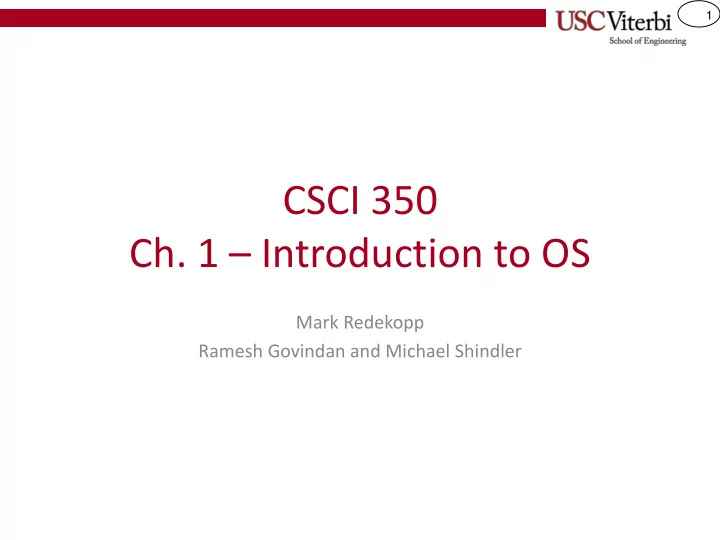

1 CSCI 350 Ch. 1 – Introduction to OS Mark Redekopp Ramesh Govindan and Michael Shindler
2 Syllabus • Website (http://bits.usc.edu/cs350) • People • Projects – PintOS – Policies • Grading & Exams
3 WHAT IS AN OPERATING SYSTEM
4 Definition • A piece of software that manages a computer’s User App User App User mode resources System System Library Library • What resources need Processes & File managing? Scheduling Systems Kernel Mode – CPU (threads and processes) I/O Drivers Memory & Protocols Translation – Memory (Virtual memory, protection) Processor Network Hardware – I/O (Abstraction, interrupts, DISK Mem. Graphics protection) Management Unit
5 HISTORY OF OPERATING SYSTEMS
6 Evolution • Single job systems – https://www.youtube.com/watch?v=XetHU_pAWOo • Batch systems: OS little more than a library for I/O – Execute the next program while outputting results from the previous – Better than before since computer wasn’t idle when processing • Multi-tasking: DMA, direct I/O access, virtual machines – Avoided I/O waiting, multiplex CPU and I/O – Virtual machines were developed around this time • Time sharing: Support interactive use of computers – Isolation (privileges), the process abstraction, memory hardware, virtual memory • PCs: bitmapped displays, window management • Mobile: SSDs, sensors/GPS, touch screen • Servers: Virtualization, optimize for specific tasks As a result of Moore's Law, features available on higher end devices find their way into lower end devices over time. Supercomputer -> server -> desktop -> mobile
7 Kinds of Operating Systems • General Purpose – Laptop, Desktop • Server – User and other access policies – Supporting virtualization (hypervisor) • Mobile • Embedded – Hard and Soft Real-time • Hard Real-time: Missing a deadline results in failure • Soft Real-time: Performance/usefulness degrades if deadlines missed • Scheduling, priority, and deterministic latency
8 Genealogy of Operating Systems Figure 1.9, OS:PP 2 nd Ed.
9 Roles • Textbook regularly revisits 3 roles an OS plays: • Referee – Protection against other applications – Enforce fair resource sharing • Why doesn't an infinite loop require a reboot? • Illusionist (Virtualization) – Each program thinks it is running separately – Each program thinks it has full access to computer's resources (or unlimited resources) • Glue – Common services (such as copy/paste) – Files can be read by any application – UI routines for look & feel – Separate applications from hardware • so you don’t need to know which keyboard, disk drive, etc
10 Case Study of Roles • What roles {Referee, Illusionist, Glue} would be relevant and important in the following systems? • Web browser • Cloud computing • Multiuser database • The Internet
11 Case Study of Roles • Web browser – Referee (execution of scripted code), glue (display and network functionality) – Illusionist (handling of network errors) • Cloud computing – Illusionist (no need to know where data is stored) and glue (to provide APIs and access) to data – Referee and Illusionist (virtualization, separation) • Multiuser Database – Illusionist (replication and transactions) – Referee (access rights) • Internet – Illusionist (DNS translation, IP routing, Reliability) – Referee (Quality-of-Service, congestion, denial of service) – Glue (Common API, standards, etc.)
12 OS Design Criteria (Metrics) • Reliability (availability) • Security/Privacy • Performance • Portability & Adoption
13 Reliability vs. Availability • Reliable: Outputs are as intended for the given set of inputs – If outputs are not as intended we say the system has failed • Availability: System can do work • Available does not imply reliable – System can be available but not reliable (bugs!) – System can be reliable yet not available • DoS, Crash after every instruction but saves results
14 Security • Security means avoiding compromised states – Example: Execution of malware/virus • Privacy implies only authorized users can access certain data • Security is hard to achieve without sacrificing other important aspects like performance (e.g. encryption, translation, etc.)
15 Performance • Scheduling and Fairness – Predictability • Throughput vs. response time
16 Portability • OS can abstract applications from various hardware changes – OS should play middle man and provide an API or AMI (Abstact Machine Interface) • Can OS itself be abstracted from hardware changes (i.e. easily ported to another HW platform) – Many OSs use a HAL (hardware abstraction layer) so that the bulk of the code need not change as it is migrated to a new platform • Adoption: The more devices that can be supported the greater the chance of adoption – Network effect: Adoption based on – If good apps are available, OS will be adopted. But good apps may not be written unless the OS is widely adopted.
Recommend
More recommend